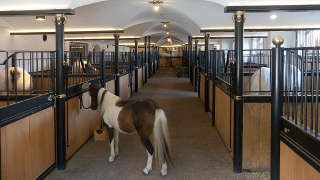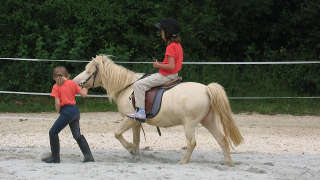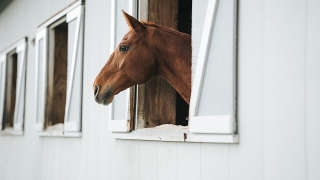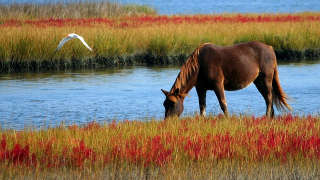Why Starting a Horse Farm Makes Sense
Ready to buy your first horse farm in Alabama, Georgia, Florida, Tennessee, or Mississippi? Equestrian businesses—offering horse boarding, training, and riding services—can be both a fulfilling lifestyle and a viable investment in the Southeast. Florida alone has a horse population of well over 300,000, ranking third in the nation (nwdistrict.ifas.ufl.edu), and other Southeastern states also host strong equine communities. With a warm climate that supports year-round riding and a steady demand for quality horse care, your first equestrian property can become a lasting and profitable operation.
Land Considerations in the Southeast
Choosing the right land is critical for a horse operation. In the Southeast, factors like topography, soil quality, climate, and access can make or break your facility’s success. Here are key land considerations for an equestrian property:
Pasture Acreage and Forage
Horses need about 2 acres per horse for grazing. Rotation helps avoid overgrazing and mud. Established grasses like Bermuda or Bahia thrive in the Southeast. Having multiple paddocks—including a dry lot—improves long-term pasture health.
Soil, Topography, and Drainage
Look for well-drained, gently rolling land. Sandy or loamy soils are ideal. Avoid floodplains or heavy clay. High ground works best for barns. Use trails or woods for recreation and avoid placing infrastructure in wet zones.
Zoning and Land Use
Confirm agricultural zoning and check county rules on livestock density and barn placement. A conditional use permit may be required. Tax incentives may apply, but due diligence prevents expensive surprises later.
Road Access and Location
Reliable road access is essential. Be close to clients, vets, feed stores, and farriers. Remote locations mean fewer customers. Buffer yourself from neighbors and check road maintenance responsibility before buying.
Infrastructure Needs: Barns, Arenas, Fencing and More
Building (or buying) the right infrastructure will set your equestrian business up for safety and efficiency. A boarding/training facility has many moving parts – quite literally – from gates and stall doors to tractors and arena drags. Below we break down the essential infrastructure you’ll need to develop or evaluate on a prospective horse farm:

Barns and Stables
Well-designed barns prioritize ventilation, storm resilience, and safe materials. Include tack storage, wash racks, lighting, and fire safety. Open-air designs and Dutch doors help manage heat and airflow.

Arenas and Riding Facilities
Outdoor arenas with sand or loam footing are common in the Southeast. Good drainage, grading, and lighting extend usability. Add round pens, trailer parking, and trails as your operation grows.

Fencing and Paddocks
Choose safe fencing like no-climb wire or board. Avoid barbed wire. Plan paddocks to allow rotation, and include a dry lot. Gates should fit tractors and hold up to daily use. Maintain regularly.

Water Systems and Utilities
Reliable water and power are essential. Use freeze-proof hydrants, safe fans, and plan for outages. Manage manure away from water sources. Backup generators and well maintenance help prevent disruptions.
Labor and Daily Management: The Day-to-Day Reality
Running a boarding and training farm isn’t a 9-to-5 desk job – it’s a sunup to sundown (and sometimes late-night) commitment. First-time farm owners should go in with eyes open about the labor and management needs. Horse care is 365 days a year, including weekends and holidays – animals don’t take days off, and a good horseman’s first priority each day is feed and water.
Expect to start early each morning with feeding and barn check, and to end each evening making sure all horses are secure and well. In practical terms, daily chores include:
- Feeding grain and hay (usually twice a day)
- Refilling water buckets and troughs
- Mucking stalls and replacing bedding
- Turnout and bring-in for pasture rotation
With 5–10 horses, these tasks can take several hours a day. You’ll also be riding, giving lessons, handling client communications, scheduling farrier and vet visits, and maintaining the property—mowing, fence repair, and dragging arenas.
Climate matters too. Southeastern summers are hot. Many barns adjust to earlier mornings and later evenings, taking a break during peak heat. Managing flies and keeping water available at all times are constant concerns.
Most new owners wear many hats: stall mucker, trainer, bookkeeper, and marketer. It’s a great way to learn, but exhausting. Hiring part-time help—like a morning worker to clean and feed—can free up time for lessons and business tasks. Many owners trade board for labor or rely on family to keep costs low.
Time management is essential. Feeding must be on schedule. Lessons start on time. Horses need regular hoof care and vaccinations. Creating and sticking to a daily and weekly routine keeps the barn efficient and safe.
Customer service is just as important as horse care. Owners want updates, responsiveness, and trust. Set clear communication expectations—when you’re available, how to reach you, and how issues are handled. A reputation for clean barns and clear communication goes far.
At the end of the day, this work is tough—but it’s deeply rewarding. Watching healthy horses graze on your land or seeing riders improve under your care makes the effort worth it. Stay organized, know your limits, and build a rhythm that works for you. The horses—and your clients—will thank you.
Plan with Clarity — Not Just Passion
Turning your equestrian dream into a sustainable business requires more than horse sense and hard work – it also means handling paperwork, legalities, and finances responsibly. Before you saddle up on this venture, make sure you cover these critical bases:
Local Regulations
Zoning laws and county rules may dictate minimum acreage per horse, barn placement, or waste management. Understand your state’s Equine Activity Liability Act, post proper signage, and get legal help drafting liability waivers and contracts. These protect your business and set expectations.
Insurance Needs
Carry liability insurance and care, custody, and control (CCC) coverage for client horses. Insure buildings against storms, fire, and theft. Maintain safety standards and post signage. Consider forming an LLC to protect your personal assets.
Financing Options
Look into USDA FSA loans, Farm Credit, or SBA loans. Have a business plan and understand your repayment ability. Grants may help with specific projects. Start modest, expand slowly, and never overextend based on hopeful projections.
Your First Ride Starts Here
Launching a boarding, training, and riding facility in the Southeast is no small task, but with smart planning and a passion for horses, it can lead to a deeply fulfilling business. This region’s horse-friendly culture and climate offer the right conditions—from Alabama to Florida, horse owners are always looking for dependable, high-quality care.
Your role as a first-time owner is to balance that passion with practical planning. That means picking the right land, budgeting wisely, building out essential infrastructure, and managing both the daily grind and long-term goals. Connect with local professionals—your vet, accountant, lawyer, farrier, and mentors—to build a support system that keeps you on track.
Yes, there will be early mornings, late nights, and the unexpected. But when your pastures are full of healthy horses and your riders are thriving, the effort pays off. This is a lifestyle as much as a business—and one worth building the right way.
At Tutt Land, we’ve helped many first-time buyers find the right horse-ready property—and we can help you too. Whether you're starting your first equestrian business or preparing to sell, our team can guide you every step of the way.
Here’s to your first equestrian venture—may it prosper and grow, one hoofbeat at a time.